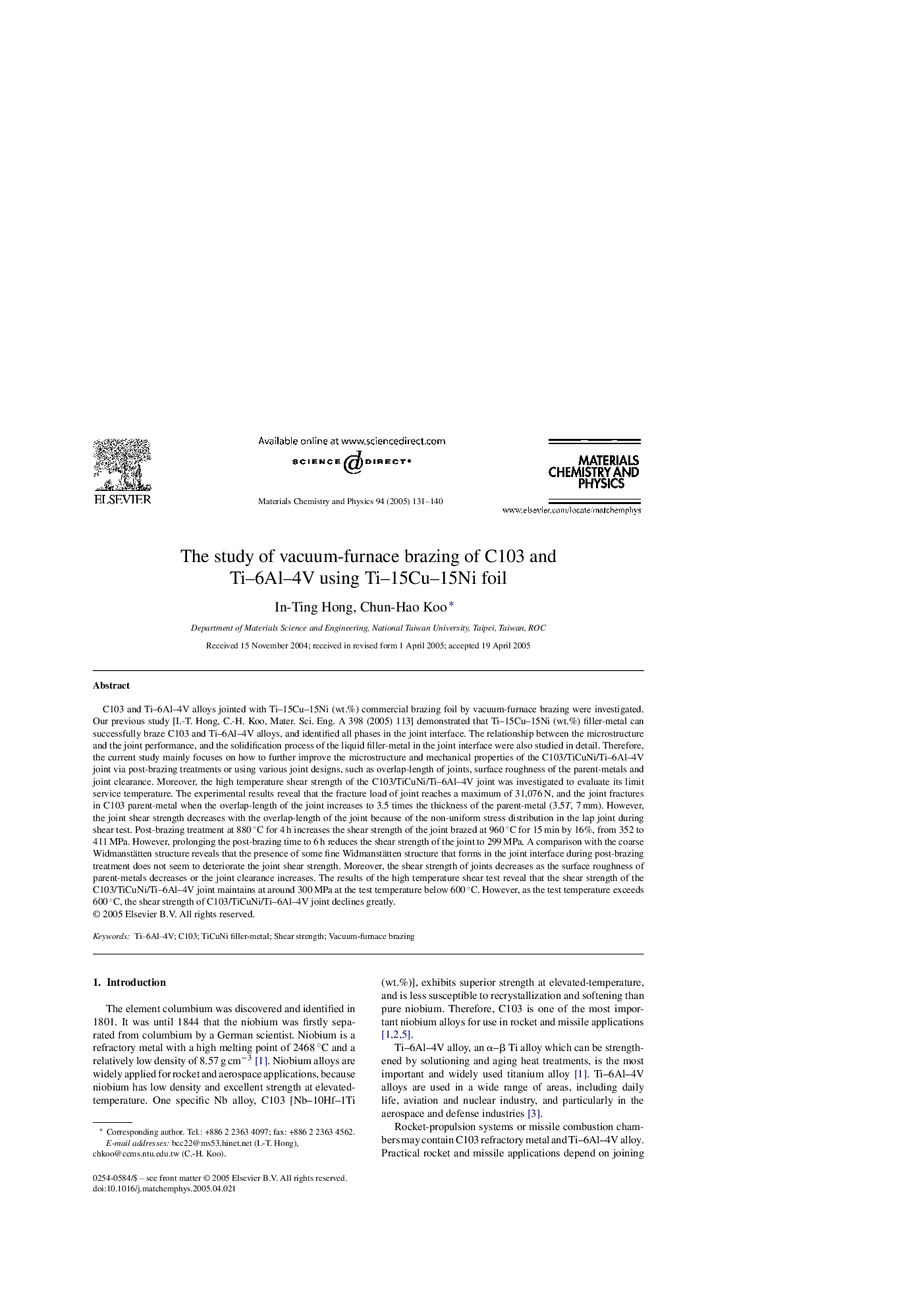| کد مقاله | کد نشریه | سال انتشار | مقاله انگلیسی | نسخه تمام متن |
|---|---|---|---|---|
| 10638191 | 995407 | 2005 | 10 صفحه PDF | دانلود رایگان |
عنوان انگلیسی مقاله ISI
The study of vacuum-furnace brazing of C103 and Ti-6Al-4V using Ti-15Cu-15Ni foil
دانلود مقاله + سفارش ترجمه
دانلود مقاله ISI انگلیسی
رایگان برای ایرانیان
موضوعات مرتبط
مهندسی و علوم پایه
مهندسی مواد
مواد الکترونیکی، نوری و مغناطیسی
پیش نمایش صفحه اول مقاله

چکیده انگلیسی
C103 and Ti-6Al-4V alloys jointed with Ti-15Cu-15Ni (wt.%) commercial brazing foil by vacuum-furnace brazing were investigated. Our previous study [I.-T. Hong, C.-H. Koo, Mater. Sci. Eng. A 398 (2005) 113] demonstrated that Ti-15Cu-15Ni (wt.%) filler-metal can successfully braze C103 and Ti-6Al-4V alloys, and identified all phases in the joint interface. The relationship between the microstructure and the joint performance, and the solidification process of the liquid filler-metal in the joint interface were also studied in detail. Therefore, the current study mainly focuses on how to further improve the microstructure and mechanical properties of the C103/TiCuNi/Ti-6Al-4V joint via post-brazing treatments or using various joint designs, such as overlap-length of joints, surface roughness of the parent-metals and joint clearance. Moreover, the high temperature shear strength of the C103/TiCuNi/Ti-6Al-4V joint was investigated to evaluate its limit service temperature. The experimental results reveal that the fracture load of joint reaches a maximum of 31,076 N, and the joint fractures in C103 parent-metal when the overlap-length of the joint increases to 3.5 times the thickness of the parent-metal (3.5T, 7 mm). However, the joint shear strength decreases with the overlap-length of the joint because of the non-uniform stress distribution in the lap joint during shear test. Post-brazing treatment at 880 °C for 4 h increases the shear strength of the joint brazed at 960 °C for 15 min by 16%, from 352 to 411 MPa. However, prolonging the post-brazing time to 6 h reduces the shear strength of the joint to 299 MPa. A comparison with the coarse Widmanstätten structure reveals that the presence of some fine Widmanstätten structure that forms in the joint interface during post-brazing treatment does not seem to deteriorate the joint shear strength. Moreover, the shear strength of joints decreases as the surface roughness of parent-metals decreases or the joint clearance increases. The results of the high temperature shear test reveal that the shear strength of the C103/TiCuNi/Ti-6Al-4V joint maintains at around 300 MPa at the test temperature below 600 °C. However, as the test temperature exceeds 600 °C, the shear strength of C103/TiCuNi/Ti-6Al-4V joint declines greatly.
ناشر
Database: Elsevier - ScienceDirect (ساینس دایرکت)
Journal: Materials Chemistry and Physics - Volume 94, Issue 1, 15 November 2005, Pages 131-140
Journal: Materials Chemistry and Physics - Volume 94, Issue 1, 15 November 2005, Pages 131-140
نویسندگان
In-Ting Hong, Chun-Hao Koo,